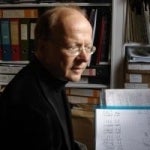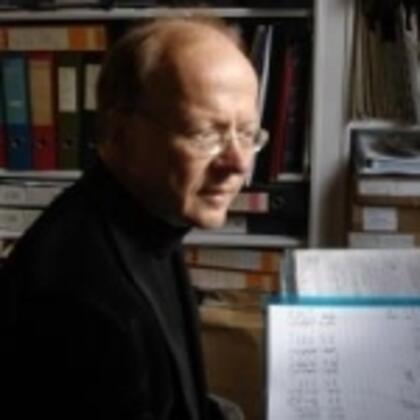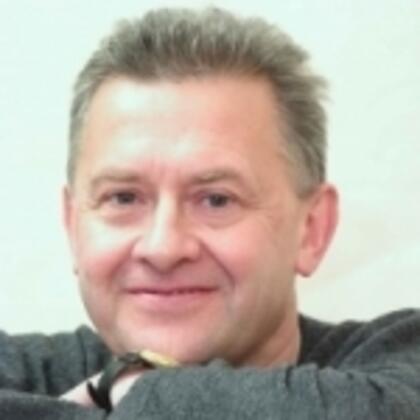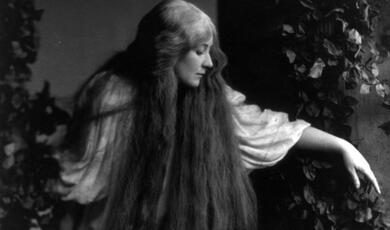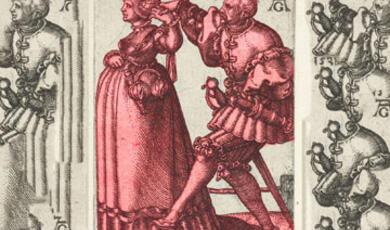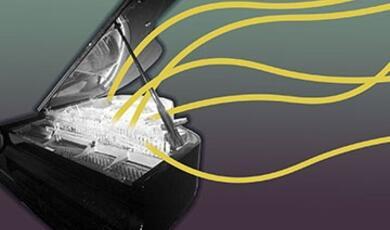Debussy - Text and Ideas: The reconstruction of Debussy's 'other' Poe opera
Share
- Details
- Text
- Audio
- Downloads
- Extra Reading
In August 1903, Debussy wrote a scenario in one act and two tableaux based on Poe’s ‘tale of mystery and imagination’, The Devil in the Belfry (1839). He planned this as a double bill with The Fall of the House of Usher (also from 1839), selling the rights to their joint premieres to the New York Met in 1908.
This joint paper discusses the problems involved in producing a fast-moving, clear and dramatically viable professional libretto from what is, in effect, a discarded text, as well as those involved in setting this to music from the sketches Debussy left (but which included a complete Prelude to the first tableau from a ‘spot the composer’ competition in the journal Musica from January 1905).
The lecture is illustrated with extracts from the concert premiere on 28 January 2012 in Montreal with the Orchestre 21 conducted by Paolo Bellomio.
Download Text
13 April 2012 Le Diable dans le Beffroi (1902 – 1912?) Robert Orledge and Stephen Wyatt Robert Orledge: Edgar Allan Poe (1809-49) became a guiding spirit for the artistic avant-garde in the Paris of the 1880s, to the extent that the director of the Théâtre-Libre, Aurélien Lugné, actually changed his surname to Lugné-Poë by deed poll around 1888. This fascination was stimulated by Charles Baudelaire’s translation of Poe’s Tales of Mystery and Imagination, published in 1857 as the Nouvelles Histoires extraordinaires, and it was nowhere more evident than in the famous Chat Noir cabaret in Montmartre, which Debussy frequented in the 1890s. His early interest focussed mostly on The Fall of the House of Usher, for which he wrote his own libretto and completed about half of the disturbing score between 1908 and his death. My completion of this was premiered at the Bregenz Festival in 2006 and is available on DVD (Capriccio 93517). However, Debussy’s attention was first drawn to The Devil in the Belfry, in the firm belief that he must create a different operatic sound world after his international success with Pelléas et Mélisande in 1902. If he had changed the perception and potential of opera for the twentieth century by setting Maeterlinck’s Symbolist prose directly in flexible, speech-related recitative, in which the elusive characters sang their most important lines in orchestral silence, then he must find other conventions to overturn in his next opera. Coincidentally, as an impoverished artist, he found he could extract money from his new publisher, Jacques Durand, on the basis of his operatic ideas and promises of completion, without ever having to deliver the finished product. He also exaggerated its dimensions, claiming it was in two acts and three tableaux in a contract of October 1903.[1] Such was the power of a successful opera in France at the time, though this factor contributed to a career that included around 50 theatrical projects, but only two masterpieces - Pelléas and Jeux - that Debussy completed entirely by himself. So, even if he produced a scenario (Fig. 1) and around 70 bars of musical sketches for The Devil in the Belfry to keep Durand happy, and also sold both Usher and The Devil to Giulio Gatti-Casazza of the New York Met (now conceived as a double bill of one-act operas) in 1908,[2] no known further progress seems to have been made on The Devil beyond 1905, even if we find Debussy playing ‘several very picturesque and typical fragments on the piano’ to Henri Busser as late as March 1912.[3] But Debussy thought a great deal about his new opera. In June 1902 he asked André Messager to read (or re-read) this story so that you can advise me. Something can be drawn from within it in which the real world would blend with the fantastic in harmonious proportions. One might also find there an ironical and cruel devil, much more of a devil that the sort of red-hot brimstone clown which we illogically regard as traditional. I’d also like to destroy the idea of the Devil as the spirit of evil! He’s more simply the spirit of contradiction and it’s he perhaps who whispers to those who don’t think like everyone else?[4] After he finished the Estampes in July 1903, Debussy compiled his scenario in two scenes, though he never uses Poe’s pun for the name of the clock-watching Dutch village in which the action begins and ends - ‘Vondervotteimittis’. Neither did he provide any names for his characters and here I’d like to bring in Stephen Wyatt to explain his creations, and tell us a bit about how he set about creating a dramatically viable professional libretto from the outline Debussy left. The main passages relating to the music are underlined on Fig. 1. Stephen Wyatt: Puccini famously described himself as ‘a mighty hunter of wild birds, opera librettos and beautiful women’. It was a very exciting challenge to be asked by Robert to create a libretto that involved - even at second hand - collaboration with a great composer. A libretto, of course, isn’t simply creating words to be set to music. The words must be succinct because long-winded explanations and extended declarations of intent rarely inspire good stage music. Roughly speaking, words take twice as long to sing as they do to speak. But the libretto must also, as economically as possible, clearly delineate its characters, chart their development and provide some sort of ground plan for the staging of the opera. Actions often speak louder than words and so what’s being seen on stage is as important as what’s being said. Sometimes more important. Debussy had obviously thought about these things in preparing the scenario for The Devil in the Belfry. The original Poe story goes no further than the appearance of the Devil and the chaos caused by the clock striking thirteen. Debussy had already developed the story into a second scene in which the Devil unleashes an Italian bacchanalia in this sedate Dutch village. He’d also thought about the essential characters he needed to tell his story – the young lovers – to whom we gave the names Jean and Jeannette - being his creation not Poe’s. He’d created a character – the Devil – totally conceived in terms of mime and music rather than dialogue. And he’s described the stage action – particularly at the end of the first tableau - in some detail. But when we started to create a libretto, a number of problems emerged and solutions had to be found. One thing that Robert was clear about from the start - to my immense relief – was that the piece should, as Debussy intended, be in prose not rhyme, which helped me to give the dialogue the precision and economy I felt it needed. A further reason for the economy was the fact that my libretto was going to be translated into French before being set which would inevitably involve expansion. Incidentally, in the end, the only phrase in my libretto for which my excellent translators could find no equivalent was “Time and tide wait for no man.” We’ll be returning to some more of the problems faced in realising Debussy’s scenario later on, but for the moment I’d like to give one example. In the libretto, we read near the start: “The burgomaster and his daughter appear – short family scene. They part.” Not many clues there. But later we read – “The burgomaster’s daughter, timid as a tulip” is greeted by the bellringer’s son who loves her. “They discuss growing tulips, discreet allusions to the love he feels for her.” This being Holland, tulips are obviously on everybody’s mind. From this clue, I decided to raise the heady subject of tulips right from the opening scene between the burgomaster and his daughter, setting the seed as it were, for what is to come. BURGOMASTER: Remember you are sixteen now. And today is the first day of spring. The tulips are in full bloom. JEANETTE: But I don’t understand, papa, why should I be careful? BURGOMASTER: Because you are young and it is spring. Do I have to explain everything? RO: In our first example, the Prelude is entirely by Debussy, appearing in a ‘Spot the Composer’ competition in Musica in January 1905 – as Supplement 28, piece 6 on p. 9. Few readers were correct in their identifications and some thought it was composed by Erik Satie. This material was much used in various transformations elsewhere in opera. The children’s ronde takes up Debussy’s opening lines in the scenario, with the counterpoint in the third verse ‘suggesting that they will later be good, grave Dutchmen’. At least I hope it does. However, I used a French folksong ‘Savez-vous planter les choux’ here, both because Debussy and Satie had a special affinity for these, and because it ties in with the other theme of cabbages in Poe and Baudelaire. You can hear material from Debussy’s Prelude again in the children’s Polka that follows (Fig. 2, Ex. b), and this leads into the duet between the Burgomaster and his timid, naïve daughter, Jeannette (from which Stephen quoted you an extract). Then to the second duet between the Burgomaster and the monosyllabic fishing bellringer, who only catches a fish after the noisy Burgomaster has gone (Stephen’s invention). Incidentally, the Burgomaster’s emotional passage about the need for order and tradition derives from the wonderful theme which ends Debussy’s last piano composition: ‘Les soirs illuminés par l’ardeur de charbon’ - a quote from Baudelaire’s Le Balcon that has the same atmosphere and key as the final bars of Debussy’s Prelude for The Devil (see Fig.2, Exx. d and g). EX. 1: The start of Tableau 1 to the end of the second duet (VS 1-19) in the recording of the world premiere in Montreal on 28 February 2012 with the Orchestre Vingt-et-un conducted by Paolo Bellomio. Burgomaster: François Nicolas Guertin (Bar) Jeannette (his daughter): Geneviève Colletta (S) Le Haut-Sonneur: Simon Chalifoux (B) Jean (his son): Chris Coyne (T) Le Diable: Vlad Horia Guzu Robert Orledge: On 12 September 1903, Debussy told Messager that ‘The [Devil’s] scenario is pretty nearly complete; the colour of the music I wish to use is more or less fixed’ and commented that ‘the worst thing of all is “to begin one’s career all over again [after Pelléas].”’[5] So Debussy passed on to the perhaps less demanding task of composing La mer. After this, we have a tantalising glimpse of Debussy’s ‘new way of treating voices’ in a letter to Durand in 1906,[6] and The Devil comes up briefly in letters to André Caplet and Durand in September 1909.[7] Then on 6 February 1911 Debussy told his Swiss friend Robert Godet that he’d ‘postponed’ both Poe operas ‘indefinitely’ because of more pressing work on Khamma and Le Martyre de Saint Sébastien. But he does explain that I’d like to arrive at an extremely simple, but nevertheless extremely supple sort of choral writing…The placing of the chorus in [Mussorgsky’s] Boris [Godunov] doesn’t satisfy me, any more than the persistent choral counterpoint in the second act of [Wagner’s] Die Meistersinger, which moreover causes nothing but cold confusion. Something else needs to be discovered: an ingenious oral deception, for instance. It’s the very devil! - without counting on that ridiculous practice of segregating the chorus by sex as if they were in the public baths! [8] According to Léon Vallas, Debussy expanded on this idea to the critic Pierre Lalo, claiming that the people of Boris don’t form a real crowd. Sometimes one group sings, sometimes another…and generally they sing in unison. As for the crowd in Meistersinger, they’re not a crowd either, they’re an army solidly organised in the German manner, marching in rows. What I’d like to achieve is something more scattered and split up, something both nimble and intangible, something apparently inorganic, and yet with underlying control - a real human crowd in which each voice is free and in which all the voices combined nevertheless produce the impression of an ensemble.[9] With this in mind, I asked Stephen to write the text for a chorus after the liberated adult villagers are transported into their wild bacchanalian orgy in an Italian village in the second tableau, for they’re just onlookers in the first. They dance a wild tarantella and I’ll ask Stephen to tell you a bit about the chorus that follows. Stephen Wyatt: The opening of Scene Two is where Debussy’s scenario finally takes leave of Poe’s original story. The Devil has unleashed the villagers from their time-fixated and repressed existence into a sense of sexual and emotional liberation. It’s as if somebody’s been handing round the “e” tablets or the snorts of cocaine. What we wanted to do in this section was to retain the sense of the villagers as individuals but at the same time show them caught up in a communal freak out. Our solution was to create a series of short rhythmic lines that could be given to individuals and made to overlap and be repeated – “I don’t care what time it is... I don’t care who sees me... I’ve lost control of myself... Me too” and so on. But then to form these comments into three sections with a repeated refrain at the end of each section where they become an ensemble – “What joy! What pleasure! .. At last I feel free... Finally free!” In writing a libretto, as I suggested earlier, it’s not simply a matter of providing words to be set to music, but working out what’s going on on stage and what words are needed and what words aren’t. Oh, and keeping tracks of where everyone is. In Debussy’s scenario, for example, there’s the case of the missing bellringer. He goes up into the tower to ring the bell in Scene One and is never heard of again. What’s he supposed to be doing while the devil takes over the belfry and starts to create anarchy? Our solution was to have him trapped in the Tower, unable to move because of the Devil’s spell. And so, at the start of scene two, he’s still stuck in the belfry and looking down miserably at all the fun he’s missing. Robert Orledge: The second extract begins with a transformational Interlude that reflects on the Baudelaire Les soirs illuminés theme (Fig. 2, ex. g) from the second duet, with a passage of pure Debussy as its climax (ex. e), leading into the whirling tarantella and chorus that begin the second tableau. EX. 2: Tableau 2 from the start to the end of the chorus (VS 42-59). Robert Orledge: The next extract comes more directly from Debussy’s scenario - as realised by Stephen - and takes us back to the end of Tableau 1. It begins with the fourth (of the four continuous) duets, here between the Bell-ringer and his son Jean, as they get ready to ring the bells. Stephen Wyatt: Exposition in opera as elsewhere in drama is a tricky business. The pitfalls involved in characters telling each other things they already both know for the benefit of the audience loom large for any dramatist. Here we have a classic. According to Debussy’s scenario, the bell-ringer’s son asks his father where the odd custom comes from that compels the villagers to come every day at noon to adjust their clocks. Why’s he asking now? Doesn’t he know perfectly well? In our version, the son has been away, hence his puzzlement now that his father expects him to go into training to take over his job. “I’ve seen other towns but they’re not like ours,” Jean comments. Hence his question. The father insists on the value of tradition. “It is the foundation of our life, the key to regularity and stability and the enemy to disorder and laziness.” Hopefully, ours is an adequate solution to an eternal problem. And, hopefully also, it doesn’t outstay its welcome and the audience doesn’t have time to think of any awkward questions. Robert Orledge: At the end of the fourth (truncated) verse of this duet comes another extended passage of pure Debussy, which seemed ideal for the villagers as they gather to listen to the midday carillon (based on the children’s earlier folksong) and the church clock striking 12. Or in this case 13, because this is where the ‘jolly’ whistling Devil enters and the chaos begins. The scene with the cracked bells follows (which was very difficult to realise), and then the Devil takes up the carillon theme on his violin and transforms it rhythmically into a ‘fantastic jig’ in which the villagers are made to participate. Here I put in a couple of musical jokes for good measure - references to composers Debussy disliked, with suitable ‘trombone’ comments - before the jig rises to a climax and the Devil leads the villagers towards the canal like the Pied Piper of Hamelin. He stops them from jumping in or following him across it by cutting them off with his bow ‘as a good conductor will cut off a final chord’. EX. 3: From the fourth duet to the end of Tableau 1 (VS 25-41). Returning to where we left off after the chorus in Tableau 2, the tarantella rhythm continues in the background as Jeannette flirts with the men from the chorus and laughingly rejects Jean’s declarations of love. For a brief moment of relief from the fast-moving intensity, the now less pompous Burgomaster does a little song and dance act (Stephen’s idea), and I’d like to take our final extract from this comic/fantastical opera - which has no other precedent or equal in Debussy - from just after this. The Devil first leads Jeannette and the chorus men in a return of the tarantella, and after Jean has suffered a final rejection, he goes to the belfry and sings a fervent prayer for deliverance from all the chaos the Devil has brought (again using music from Debussy’s Prelude – Fig. 2, ex. b). When he rings the bell once more, it chimes normally. Everyone is frozen to the spot. Even the Devil shudders. But this raised its own problems, as Stephen will explain. Stephen Wyatt: At the end of the first scene, Jean runs to the belfry in an attempt to ring the holy bells and put a stop to the Devil’s games. He fails because the Devil is too strong. Yet at the end of the second scene he succeeds. What’s happened in between? Our answer was that Jean’s love has been tested to the nth degree by Jeannette’s flirtatious behaviour in the Tarantella sequence, where she laughs at him mockingly and becomes in Debussy’s words “a wild peony” instead of a tulip. When he prays a second time, it has a hard-won conviction, “Here is one true heart that loves. I wasn’t strong enough before. Help me.” Robert Orledge: After the Devil has been defeated, he touches each of the villagers, who drop down as he does so. He vanishes in a flash of red light and the sky gradually brightens again, leading to a return to the Dutch village of Scene 1, and a return to the status quo. Here Debussy ends his scenario, but as this would’ve been an anti-climax on the stage, I asked Stephen to create a more convincing ending. Stepehen Wyatt: I totally agreed with Robert that the end was flat. Yes, the villagers could assemble and set their watches correctly, but there’d be a real sense of anti-climax. This is perhaps where a life spent around the world of showbiz finally kicked in. After the clock strikes twelve, let’s have the chorus of schoolchildren returning as they did at the start singing their folk song. And let’s have Jean and Jeannette as the only characters transformed by their experience singing a love duet, clasping bunches of tulips. Let the chorus and the lovers combine. And, as we’d planned from the start, let’s have the illuminated face of the Devil grinning down from the belfry as the lights dim just in case it all seems a bit too cosy. Hopefully, Debussy would have approved. EX. 4: From Jean’s prayer to the end of the opera (VS 72-79). Robert Orledge: You’ve now heard most of this 35-minute opera, in which the only thing we didn’t get in was Debussy’s Hungarian cimbalom. But these are difficult to find and would ultimately lead to fewer performances. There is some Massenet, and undoubtedly some Orledge here, but I hope any criticism will be outweighed by the opportunity to hear some rare humorous and extrovert Debussy, using his music wherever possible. And, as Romain Rolland recognised, there is something of Massenet even in Arkel’s music in Pelléas, where he famously refers to ‘the Massenet that slumbers at the heart of every Frenchman.’[10] Debussy would undoubtedly have composed much of The Devil quite differently, but in justification, I have rescued a theatrical project from dusty obscurity and, with Stephen Wyatt’s invaluable assistance, turned it into a coherent, viable, and we hope entertaining opera. Acknowledgements I should like to acknowledge here that the French translation and word-setting owe much to the kind assistance of Dr Caroline Potter, Gilles Christoph and Sabine Remanofsky. Suggested further reading Robert Orledge: Debussy and the Theatre, Cambridge, Cambridge University Press, 1980, repr. 1985, 2009 Claude Debussy (ed. Denis Herlin): Correspondance (1872-1918), Paris, Gallimard, 2006 © Robert Orledge and Stephen Wyatt 2012 [1]In BNF Rés. Vm. Dos 13 (1-2) dated 14 October 1903. [2]His contract of 5 July 1908 for 2000 francs also offered the Met an option on La légende [L’histoire] de Tristan, planned with Gabriel Mourey in 1907. See Orledge, Debussy and the Theatre, Cambridge, CUP, 1982, pp. 251-53. [3]As recalled by Busser in De Pelléas aux Indes galantes, Paris, Fayard, 1955, p. 185. [4]Debussy (ed. Denis Herlin): Correspondance 1872-1918, Paris, Gallimard, 2006, p. 668. [5]Correspondance, p. 780. [6]Correspondance, p. 960. Letter of 7 July 1906. The new, ‘simple’ idea was to remain a secret between them. [7]Ibid., pp. 1214-15. No details are given unfortunately. [8]Ibid., p. 1385. [9]Transl. From Vallas in Lockspeiser, Debussy: his life and mind, Cambridge, CUP, 1978, vol. 2, pp. 145-46. [10]Cited by Martin Cooper in his article on Massenet in The New Grove Dictionary of Music and Musicians, London, Macmillan, 1980, vol. 11, p. 807.
Part of:
This event was on Fri, 13 Apr 2012
Support Gresham
Gresham College has offered an outstanding education to the public free of charge for over 400 years. Today, Gresham College plays an important role in fostering a love of learning and a greater understanding of ourselves and the world around us. Your donation will help to widen our reach and to broaden our audience, allowing more people to benefit from a high-quality education from some of the brightest minds.


 Login
Login
